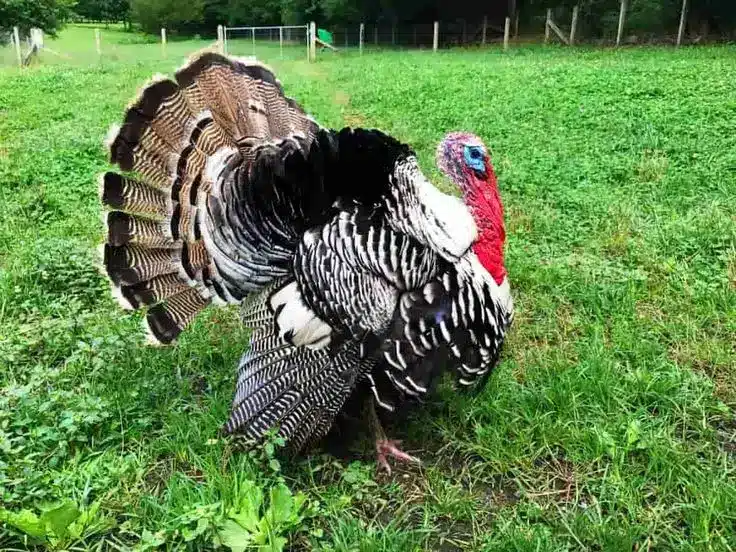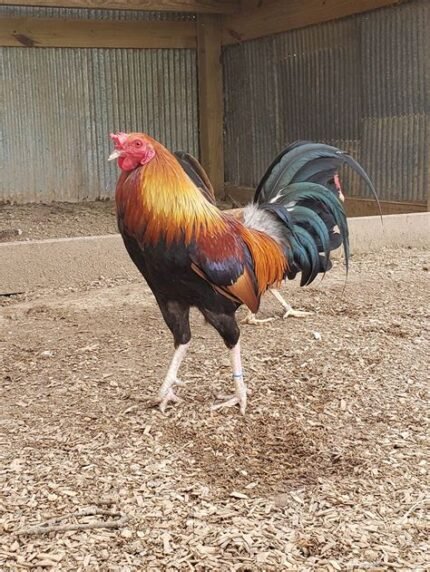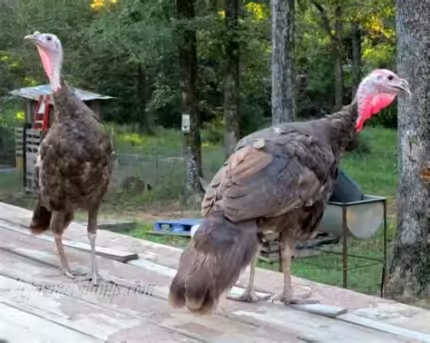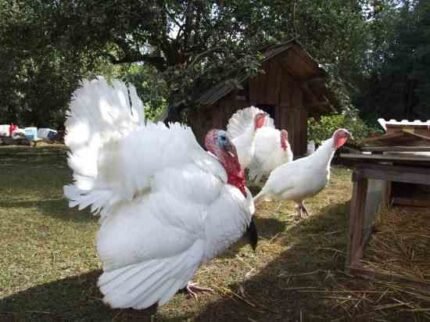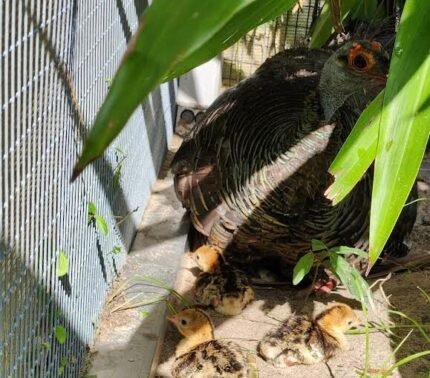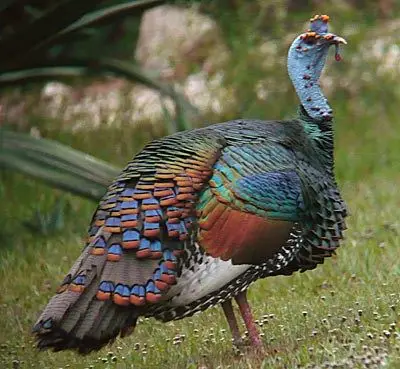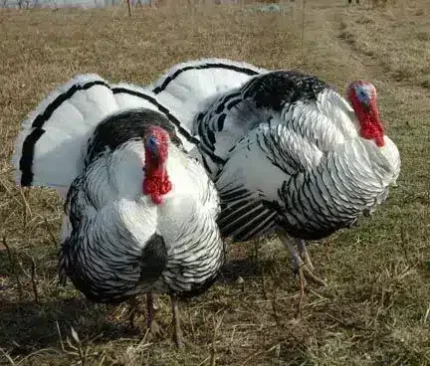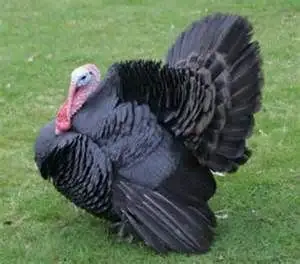
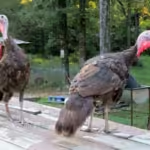
Broad Breasted Bronze Turkeys
$10.00 – $150.00Price range: $10.00 through $150.00
Searching for premium Broad Breasted Bronze Turkeys? At Gamefowls and Turkeys, we provide exceptional Broad Breasted Bronze turkeys renowned for their rich flavor, impressive size, and beautiful bronze plumage. Ideal for both backyard farming and commercial production, these turkeys offer excellent meat quality and a hearty disposition. Explore our selection today and enhance your flock with the outstanding Broad Breasted Bronze Turkeys!
Broad Breasted Bronze Turkeys: Top-Tier Quality, Flavor, and Rearing Guide
Broad Breasted Bronze turkeys offer a winning combination of substantial meat yield, rich, traditional flavor, and rapid growth, making them a premium choice for small farms and holiday tables. Whether you’re looking to purchase Broad Breasted Bronze turkeys or aiming to establish a superior homestead flock, this guide provides practical insights covering their origins, physical and behavioral traits, meat characteristics, best husbandry practices, acquisition advice, breed comparisons, history, conservation efforts, and economic potential. You’ll discover how to nurture robust poults, optimize their feed and living conditions, understand the necessity of artificial insemination for breeding, and evaluate market opportunities. Delve into detailed sections on the breed’s heritage, maximizing meat quality and flavor, selecting dependable hatcheries, and comparing Broad Breasted Bronze with other turkey varieties to empower your decisions and build expertise in turkey production.
What Defines Broad Breasted Bronze Turkeys? Key Traits and Origins
Broad Breasted Bronze turkeys are a domesticated breed developed by crossbreeding heritage Bronze stock with wild Eastern turkeys. This selective breeding aimed to enhance growth speed, increase breast meat yield, and produce striking iridescent plumage. The result is a bird with a broad chest, efficient feed-to-meat conversion, and the deep flavor characteristic of traditional turkeys. For instance, modern poults reach market weight faster than heritage Bronze birds, making them well-suited for both commercial and home-based farming.
The following characteristics are central to Broad Breasted Bronze turkeys and underscore their importance in meat production and small-scale agriculture:
- Exceptional breast depth and muscular build contribute to high meat yield.
- Iridescent bronze plumage offers a visually appealing appearance for marketing and seasonal presentation.
- Rapid growth rate ensures efficient feed conversion and a timely path to market.
These fundamental features lay the groundwork for exploring their physical traits, temperament, and growth patterns, which are crucial for effective raising strategies and meat quality.
What physical traits characterize the Broad Breasted Bronze Turkey?
Broad Breasted Bronze turkeys are distinguished by their broad chests, deep bodies, and iridescent plumage that shimmers with copper and bronze hues in sunlight. Their skeletal structure has been refined through selective breeding to support significant breast muscle development, thereby increasing carcass meat yield. This robust conformation also necessitates strong leg and joint structures, making careful attention to flooring and footing essential for their well-being.
| Attribute | Characteristic | Value |
|---|---|---|
| Average Tom Weight | Live weight | 30–38 pounds at 20–22 weeks |
| Average Hen Weight | Live weight | 21–28 pounds at 18–20 weeks |
| Plumage Color | Iridescent bronze hue | Copper, greenish-bronze sheen |
| Breast Depth | Muscular profile | Broad, deep pectoral development |
A strong skeletal foundation supports optimal weight gain and influences the design of coops and floor spaces, leading naturally into considerations of their temperament and environmental needs.
How does the temperament of Broad Breasted Bronze turkeys influence their care?
Broad Breasted Bronze turkeys generally exhibit a calm and docile temperament, which is advantageous for managing them in groups and in closer quarters. Their placid nature helps minimize stress-related injuries and promotes consistent growth when flock sizes are kept moderate. As they are typically non-aggressive, caretakers can implement structured feeding and handling routines without requiring extensive protective gear.
This agreeable disposition fosters flock cohesion and simplifies routine health checks, naturally leading into discussions about their growth rates and ideal processing ages.
What is the typical growth rate and weight for Broad Breasted Bronze turkeys?
Broad Breasted Bronze poults experience rapid growth, achieving processing weight through a high-protein diet that supports swift muscle development. Their feed conversion ratio typically averages 2.5:1 for toms and 2.9:1 for hens, indicating efficient nutrient utilization. A standard grow-out period lasts 18–22 weeks, allowing for predictable scheduling in meat production.
| Growth Stage | Age Range | Expected Live Weight |
|---|---|---|
| Poults | 0–8 weeks | 1–5 pounds |
| Growers | 9–16 weeks | 10–25 pounds |
| Finishers | 17–22 weeks | 23–38 pounds |
Understanding that peak growth occurs between weeks 10 and 18 is key for adjusting feeding and environmental conditions, setting the stage to explore why their meat is renowned for quality and flavor.
Why Is Broad Breasted Bronze Turkey Meat Celebrated for Supreme Quality and Flavor?
Broad Breasted Bronze turkey meat is prized for its rich, layered flavor profile, attributed to its natural fat distribution and the gradual development of muscle fibers, which helps retain moisture during cooking. This inherent quality results in tender, succulent breast and thigh meat that appeals to discerning palates. Home cooks and small-scale processors particularly value this characteristic for special occasion meals.
Three primary factors contribute to this supreme quality and flavor:
- Distinct Flavor Profile – Offers a deeper, more robust turkey taste compared to white-breasted varieties.
- Superior Meat Yield – Exceptional breast muscle development increases portion sizes and minimizes waste.
- Optimal Processing Window – Harvesting between 16–22 weeks ensures a perfect balance of tenderness and flavor depth.
What flavor profile sets Broad Breasted Bronze turkey meat apart?
Broad Breasted Bronze turkey meat is characterized by a dynamic umami richness and subtle gamey notes, with natural juiciness stemming from intramuscular fat. The combination of higher myoglobin levels in the dark meat and robust muscle fibers creates complex taste layers that cook evenly. For example, slow roasting enhances the subtle sweetness of the breast while preserving the succulence of the thighs.
This distinctive sensory profile encourages culinary creativity, from simple herb rubs to classic roasting techniques, and naturally leads into discussions about meat yield and size comparisons.
How do meat yield and breast size compare in Broad Breasted Bronze turkeys?
Broad Breasted Bronze turkeys can yield up to 30–35% breast meat relative to carcass weight, surpassing the average of 25–28% found in heritage and white breeds. Their large pectoral muscles provide uniform slicing surfaces, ideal for high-volume preparation. When calculating yield, producers can anticipate more retail cuts per bird, optimizing both return on investment and customer satisfaction.
The genetic potential for breast meat yield is influenced by factors such as sex, strain, and selection pressure, making optimal husbandry and management practices crucial for achieving their full potential.
Factors Influencing Breast Meat Yield in TurkeysThere is a global demand for turkey products, with breast meat from these birds being highly valued. Breast meat is arguably the most significant component of the carcass, making it crucial to investigate factors that influence Breast Meat Yield (BMY). The BMY trait is affected by both genetic and environmental factors throughout all developmental stages, from pre-hatch to the conclusion of the commercial growing period. Additive genetic effects appear to be the predominant influence on BMY, with limited evidence of heterosis or maternal inheritance. The genetic potential for BMY is influenced by sex, strain, and selection pressure within a pure line, impacting both muscle morphology and yield. For a turkey to achieve its full genetic potential for BMY, optimal husbandry and management practices are essential.Factors affecting breast meat yield in turkeys, SP Miller, 2010
| Breed Comparison | Breast Yield (%) | Carcass Weight (Average) |
|---|---|---|
| Broad Breasted Bronze | 30–35 | 20–28 pounds dressed |
| Broad Breasted White | 25–30 | 18–24 pounds dressed |
| Standard Bronze | 22–26 | 15–20 pounds dressed |
The higher breast yield in Bronze stock supports greater sale weight and premium pricing tiers, leading into the discussion of processing timing to maintain peak quality.
What is the optimal processing age and weight for the best meat quality?
The ideal processing age for Broad Breasted Bronze turkeys falls between 16 and 22 weeks, when birds typically weigh between 23 and 38 pounds live. This timeframe allows muscle maturity to align with optimal tenderness and flavor development. Processing too early may result in underdeveloped flavor, while delaying beyond 24 weeks can lead to a coarser texture and reduced feed efficiency.
Harvesting within this age-weight bracket ensures the best balance of tenderness, flavor, and economical feed conversion, setting the stage for raising and feeding guidelines.
How to Raise Broad Breasted Bronze Turkeys: A Comprehensive Care and Feeding Guide
Raising Broad Breasted Bronze turkeys requires a structured approach that incorporates effective brooding practices, multi-stage feeding, suitable housing, diligent health management, and specialized breeding techniques. This comprehensive care strategy supports consistent growth, animal welfare, and high meat quality, making it practical for both homesteaders and small-scale producers.
Key stages include brooding poults, implementing progressive feed regimens, optimizing their environment, employing preventive health measures, and utilizing artificial insemination for successful breeding.
What are the best practices for caring for Broad Breasted Bronze turkey poults?
Caring for day-old poults involves maintaining a brooder temperature of 95°F during the first week, gradually reducing it by 5°F each subsequent week until they can tolerate ambient temperatures. Providing constant access to fresh water and a starter feed with 28–30% protein is crucial for immune development and skeletal growth. Ample floor space and non-slip bedding help minimize leg issues associated with their rapid early growth.
- Ensure the brooder space is clean, draft-free, and offers temperature gradients.
- Offer grit to aid crop function and calcium for bone development.
- Monitor poult behavior closely and adjust heat lamps as needed to prevent huddling or dispersal.
Attending to their environment and nutrition from the start lays the foundation for efficient growth and robust health.
What feeding regimen supports healthy growth in Broad Breasted Bronze turkeys?
A tiered feeding program optimizes growth efficiency: starter feed (28–30% protein) for weeks 0–8, grower feed (20–24% protein) for weeks 9–16, and finisher feed (16–18% protein) for weeks 17–22. High-quality grains, supplemented with essential vitamins and minerals, ensure optimal feed conversion and muscle development.
Research into the nutritional makeup of Broad Breasted Bronze turkey muscle highlights the significance of a balanced diet for their optimal development.
Nutritional Composition of Broad Breasted Bronze Turkey MuscleThe nutritional value and physicochemical properties of male and female Broad Breasted Bronze turkey muscle were investigated. This study sought to compare the nutritional profile, encompassing proximate composition and fatty acid profile, of breast and thigh muscles from Broad Breasted Bronze turkeys, considering variations related to sex and age.Nutritional value and physicochemical properties of male and female broad-breasted bronze turkey muscle, A Czech, 2024
| Feed Phase | Protein Level (%) | Duration (Weeks) |
|---|---|---|
| Starter | 28–30 | 0–8 |
| Grower | 20–24 | 9–16 |
| Finisher | 16–18 | 17–22 |
Structured feed transitions help prevent digestive issues and prepare the birds for their target processing weight, while also managing feed costs effectively.
How much housing space and what environmental conditions do Broad Breasted Bronze turkeys need?
Broad Breasted Bronze turkeys require a minimum of 4–5 square feet per bird when housed indoors and 8–10 square feet per bird in a free-range setting to accommodate their size and minimize stress. Solid-fenced enclosures offer protection against predators, and roosting bars should provide at least one foot of linear space per bird. Proper ventilation and dry litter are essential for preventing respiratory problems.
Allocating adequate space and providing environmental enrichment promotes well-being and uniform growth, leading to healthier outcomes at processing time.
What health issues affect Broad Breasted Bronze turkeys, and how can they be prevented?
Broad Breasted Bronze turkeys can be susceptible to leg disorders, blackhead disease, and respiratory infections, often due to their rapid growth and dense housing conditions. Prevention strategies include maintaining dry bedding, rotating pasture or pen flooring, vaccinating against common pathogens, and implementing biosecurity protocols to limit cross-contamination.
Early detection through regular visual inspections and the proactive inclusion of coccidiostats in their feed can reduce morbidity. These measures help minimize losses and uphold ethical production standards.
Why is artificial insemination necessary for breeding Broad Breasted Bronze turkeys?
Artificial insemination is necessary because the breed’s oversized breast conformation and limited male mobility make natural mating difficult or impossible. This controlled breeding method helps ensure fertility rates exceeding 90% and predictable hatchability. Precise semen collection and insemination scheduling maximize poult yield and genetic consistency.
Adopting this breeding technique is fundamental for sustainable flock expansion and maintaining the breed’s desirable meat-yield traits.
Where Can You Purchase Broad Breasted Bronze Turkey Poults and What Should You Consider?
Finding reputable hatcheries and understanding purchasing considerations are key to starting with healthy poults that will achieve expected growth and quality. Availability can vary by region and season, so placing orders well in advance of spring or fall hatching seasons helps secure prime stock.
Which hatcheries offer Broad Breasted Bronze turkey poults for sale?
Several specialized hatcheries offer Broad Breasted Bronze poults, typically selling day-old birds with health guarantee programs. Look for suppliers who vaccinate poults at hatch, provide detailed care instructions, and maintain rigorous biosecurity standards. Many hatcheries offer limited seasonal releases timed for national holidays.
Choosing a hatchery with established hatch rates and transparent sourcing practices will support your flock’s success from day one.
What are the pricing and availability considerations for Broad Breasted Bronze poults?
Broad Breasted Bronze poults generally command a higher price than heritage breeds, typically ranging from $10 to $20 per bird, depending on order volume and shipping distance. Seasonal demand peaks in late winter and early summer, so ordering early helps secure better availability and reduces shipping stress for the poults.
Budgeting for shipping costs and minimum order quantities is important for managing upfront investment and ensuring you acquire a sufficient number of birds for your flock.
How to select healthy poults for your flock?
Healthy poults are active, have clear eyes, a clean vent area, and stand upright. Inspect the packaging upon arrival for temperature indicators and confirm minimal mortality claims. Upon receipt, provide immediate access to water with electrolytes and observe the poults closely for the first 72 hours to ensure they are vigorous.
Starting with robust, healthy stock minimizes stress-related mortality and establishes a foundation for uniform flock performance.
How Does the Broad Breasted Bronze Turkey Compare to Other Breeds?
Comparisons help illustrate how Broad Breasted Bronze turkeys measure up against popular alternatives, guiding breed selection based on meat yield, flavor, growth rate, and breeding requirements. Understanding these differences informs production goals, whether focused on culinary excellence, conservation, or natural breeding capabilities.
What are the differences between Broad Breasted Bronze and Broad Breasted White turkeys?
Broad Breasted White turkeys share similar growth rates and feed conversion ratios but possess white plumage, which simplifies commercial processing by minimizing visible pin feathers and reducing labor costs. However, their flavor is generally milder compared to the robust taste of Bronze meat. White birds often achieve a slightly lower premium due to their less traditional appearance.
This contrast highlights why producers might choose Bronze for specialty markets and White for high-volume operations.
How does the Standard Bronze turkey differ from the Broad Breasted Bronze?
Standard Bronze (heritage) turkeys mature more slowly, requiring 26–30 weeks to reach market size, but they can breed naturally without the need for artificial insemination. Their smaller frame yields less breast meat but offers enhanced flavor complexity and contributes to genetic diversity. The conservation status of Standard Bronze turkeys is significant, supporting efforts to preserve heritage breeds.
Studies comparing the growth performance of heritage turkeys indicate that while Bronze heritage turkeys can achieve substantial weights, their growth rates may differ from those of commercial strains.
Growth Performance of Bronze Heritage TurkeysThis study aimed to compare the growth performance of White, Black, and Bronze heritage turkeys recently introduced in Bangladesh. The birds were raised under a semi-intensive system at the BAU Poultry Farm, supplemented with commercial broiler grower and layer feeds. The primary objectives were to investigate the growth performance of locally available heritage turkeys under a semi-intensive rearing system and to propose turkey as a supplementary component to existing poultry businesses in the country. A total of 46 unsexed poults, aged 5 weeks, comprising White, Black, and Bronze color types, were housed. The birds were managed under identical conditions and fed commercially sourced feed. No statistically significant difference (p>0.05) in live weight was observed among the three color types. By the conclusion of the 21-week rearing period, Bronze turkeys achieved the highest average live body weight (3720.71g/bird), while White turkeys recorded the lowest (3282.29g/bird).Growth performance of white, black and bronze color heritage turkeys under semi-intensive system: Growth performance of heritage turkeys, SC Das, 2018
Heritage and commercial strains serve distinct market segments, catering to both slow-food enthusiasts and large-scale producers.
What distinguishes Broad Breasted Bronze turkeys from Wild Turkeys?
Wild turkeys possess leaner muscle structures, longer legs, and greater agility, with darker, more varied plumage. Their meat is leaner and gamier but yields significantly less breast meat. Wild birds require minimal human intervention but lack the predictable uniformity and size advantages of commercial Bronze stock.
Comparing these breeds clarifies the trade-offs between natural behavior, nuanced flavor, and production efficiency.
What Is the History and Conservation Status of Broad Breasted Bronze Turkeys?
Broad Breasted Bronze turkeys emerged in the early 20th century from crosses between heritage Bronze and Eastern wild turkeys, with the goal of increasing breast muscle and accelerating growth. Selective breeding for muscular depth and feed efficiency shaped the modern commercial breed by the mid-20th century.
How did the Broad Breasted Bronze turkey develop historically?
Early poultry breeders aimed to combine the rich flavor of heritage strains with the size benefits of wild stock, resulting in a turkey with broad breast capacity and rapid growth. This development coincided with increasing holiday demand, making Bronze turkeys the dominant commercial variety until the 1960s.
The subsequent shift to white-feathered strains for cleaner processing marked a change in commercial preferences.
What caused the commercial shift from Broad Breasted Bronze to Broad Breasted White?
Processors began favoring Broad Breasted White turkeys in the 1960s to minimize visible pin feather remnants, thereby reducing labor costs during evisceration. White-plumaged birds also aligned with evolving consumer preferences for a cleaner carcass appearance. This shift led to Bronze flocks being relegated to niche and heritage markets.
A renewed interest in traditional flavor and pasture-raised meat has since contributed to the resurgence in Bronze turkey popularity.
What is the current conservation status and market trend for Broad Breasted Bronze turkeys?
While Standard Bronze turkeys are classified as critical by conservation organizations, Broad Breasted Bronze populations remain stable within small-scale and specialty operations. Market trends indicate a revival driven by heritage food movements, direct-to-consumer sales channels, and seasonal restaurant demand for richly flavored poultry.
Growing interest in pasture-based and artisanal production is fostering broader support for heritage turkey conservation and premium pricing.
What Are the Economic Benefits and Practical Considerations of Raising Broad Breasted Bronze Turkeys?
Broad Breasted Bronze turkeys offer strong economic returns through efficient feed conversion, high breast meat yields, and premium market positioning. Careful cost analysis and production planning can optimize profitability while upholding animal welfare and product quality standards.
How efficient is the feed conversion ratio for Broad Breasted Bronze turkeys?
Broad Breasted Bronze toms typically achieve a feed conversion ratio of around 2.49:1, and hens around 2.92:1, demonstrating high efficiency in converting feed into edible meat. This metric helps reduce overall feed costs per pound of gain compared to slower-growing heritage breeds, leading to faster break-even points.
Consistent monitoring of feed intake and weight gain is essential for maintaining target conversion rates and informing adjustments to the feeding program.
What are the expected economic returns from raising Broad Breasted Bronze turkeys?
Producers can anticipate revenues ranging from $3–$6 per pound on dressed weight, with high yields of 30–35% breast meat commanding premium prices. Assuming an average dressed weight of 25 pounds and feed costs of $0.30–$0.35 per pound of gain, net margins can exceed 30% per flock cycle in direct-to-consumer sales.
Strategic pricing and value-added services, such as custom processing or specialty seasoning, can further enhance profitability.
What are the best practices for maximizing meat yield and quality for sale?
Implementing precise feeding schedules, maintaining optimal health management, and timing processing at peak condition are crucial for maximizing carcass weight and meat quality. Rotational pasture access can enhance flavor through foraging while reducing bedding costs. Marketing messages that emphasize the breed’s heritage and rich flavor profile support premium positioning.
Effective record-keeping and quality control measures ensure consistency across batches, reinforcing buyer trust and encouraging repeat business.
Broad Breasted Bronze turkeys provide unparalleled advantages for producers seeking supreme quality, heritage appeal, and efficient meat production. By understanding their unique characteristics, proactively managing husbandry and health, and capitalizing on market trends, farmers and homesteaders can leverage the breed’s distinct value proposition and savory flavor. Begin your flock with confidence by purchasing Broad Breasted Bronze turkeys and experience the difference in texture, taste, and economic returns.
| Quantity |
Male ,Female ,Chick |
|---|
